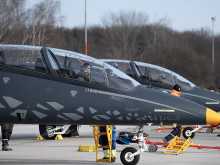We visited the object protection department of the Military Police
Our editorial team had the opportunity to get personally acquainted with the activities of the MP's object protection department. The visit included a presentation of the capabilities of the unique Security and monitoring system (SOM 6), including the TAROS unmanned semi-autonomous vehicle (UGV), which is part of the system.
Video: We visited the object protection department of the Military Police | CZ DEFENCE
Throughout our visit, we were accompanied by Lieutenant Colonel Roman Kremser, Chief of Object Protection and Special Activities of the Military Police Headquarters, who introduced us to the various capabilities and systems.
We were able to see the sixth-generation protection and monitoring system (SOM), which is used to monitor or guard objects of interest. The system replaces the otherwise large deployment of live forces (up to hundreds of soldiers) in monitoring the target area and has a number of different monitoring and detection systems. For example, it includes three sensor units which includes infrared cameras and colour cameras with laser illumination. SOM 6 also has a perimeter protection system comprising LiDAR (Light Detection And Ranging) and IP cameras, infrared beacons and microwave barriers.

SOM 6 is also equipped with a medium-range system consisting of a PTZ (Pan-Tilt-Zoom) camera (360° rotating camera with IR illumination) and a set of IP cameras. The SOM 6 also includes an unmanned aerial vehicle (drone) with colour and IR camera and a drone jammer.
The SOM 6 system also includes the aforementioned TAROS unmanned vehicle, which can supplement the overall monitoring of the guarded perimeter if necessary. The vehicle is guided by LiDAR cameras and GPS antennas, and includes a PTZ camera including a laser illuminator. TAROS, as well as the sensor unit, also allows two-way audio communication (microphones/speakers) and visual communication via a text LED panel. The vehicle, which has a hybrid drive system, has very good manoeuvrability, which is aided by steerable front and rear axles that also allow for "crabbing" – a maneuver allowing sideways movement.

The system is designed for three operators, with two always on duty and the third resting. In this way, the system is able to guard the selected perimeter continuously and for a long period of time. If the SOM 6 subsystems (including the TAROS unmanned vehicle) detect a breach of the guarded perimeter, it immediately informs the system operators, who then evaluate the breach and its level of danger based on the image data. Based on the operators' decision, a regular patrol is called to the site, which also includes a dog handler with a service dog. If the situation requires it, reinforcements in the form of members of the Police of the Czech Republic or members of the Emergency Department of the MP may be called to the site. The emergency units are mainly intended for quick and effective intervention against persons committing illegal acts under the Military Police Act and for dealing with emergencies within the Ministry of Defence. The Emergency Departments may then include, for example, bomb squads, snipers, combat medics, splicers (IT specialists) and drivers, who form intervention groups that then carry out the relevant intervention in the given facility. They use special techniques, material and equipment to carry out a successful intervention and are therefore the select component within the individual Military Police services. We have had the opportunity to see first-hand just such an intervention by a SWAT team against an offender who does not respond to previous challenges. Although it was only a training exercise, it was obvious at first glance how important the speed and complete interplay of the entire response team is.

SOM 6 has been deployed for example at various public events such as BAHNA, IDET, NATO Days or in 2021 it was deployed in South Moravia as part of the protection of buildings after a devastating tornado. Other generations of the SOM system have been deployed, for example, in Vrbětice or in foreign operations in Iraq or Kosovo.
The Military Police currently has three protection and monitoring systems, namely SOM 3, SOM 5 and SOM 6. SOM 3 was upgraded to SOM 6 2 years ago and now SOM 5 is being upgraded to the same level. In the context of cooperation of individual SOMs, the advantage is the compatibility of individual systems, where they can be freely interchanged or added to increase the monitoring capability of the target area. All SOM systems are fully digital, so the entire perimeter is guarded autonomously and the operator only intervenes when the perimeter is breached, thus not having to check the monitors 24 hours a day.

During our visit we asked Lieutenant Colonel Roman Kremser several questions.
What new equipment is being prepared for the Department of Object Protection and Special Activities of the Military Police?
The Military Police is keeping up with technological developments and responding to the current situation. Currently, we are acquiring jammers for unmanned aerial vehicles, not only the SOM 5 system is being upgraded, but also other systems already in place, which are very often deployed in real events. These include, for example, a mobile system for perimeter protection, technical support for a small protection team, and so on.
What is the staffing of the department and what expertise is missing?
The issue of understaffing in the Military Police is still topical, for this reason we are actively looking for new officers across all specialties, both in direct police performance, such as in the object protection department, traffic and order service, emergency department or the department of protection of persons or escorts, but also in staff positions.
Do members of the Military Police's Object Protection Department participate in any international exercises and which ones? What experience do they take away from them?
Members of the Object Protection Department have participated in, for example, the international exercise SHARP LYNX and are also assigned to task forces. The experience gained from these exercises is then put to good use during their deployments in foreign operations.
























